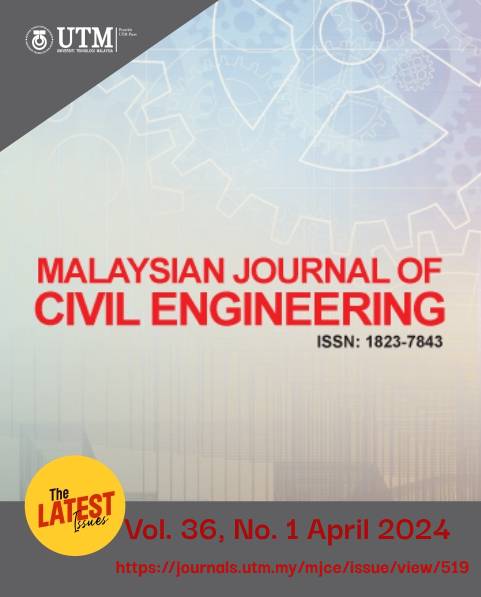EVALUATION OF GROUND BORNE VIBRATION WITH RESPECT TO PILE DRIVING
DOI:
https://doi.org/10.11113/mjce.v36.21649Keywords:
Ground Borne Vibration, Pile Driving, Peak Particle Velocity, prediction modelAbstract
Construction activities contribute to ground-borne vibrations, leading to structural damage and adverse environmental effects like noise pollution and human discomfort. Piling, particularly dynamic piling using a hammer drop, is a common construction practice in Malaysia for erecting high-rise buildings. However, this activity, if conducted near urban or residential areas, can result in various issues such as soil settlement and structural damage. Pile-induced vibrations result from the energy transfer initiated by the hammer drop, transmitting through the pile and subsequently propagating into the surrounding soil.he damping effects of these waves decrease with increasing distance from the pile, while the energy transferred to the ground rises with the depth of pile penetration. The relationship between the distance of the pile from the vibration source and Peak Particle Velocity (PPV) is inversely proportional, indicating that as the distance increases, the PPV decreases. Conversely, the relationship between pile depth and PPV is directly proportional, implying that as the pile depth increases, the PPV also increases. The analysis reveals that Peak Particle Velocity (PPV), distance, and pile depth exhibit similar positively skewed distributions with negative kurtosis. Negative linear correlation exists between PPV and distance, while a positive correlation is observed with pile depth. The multiple linear regression equation, PPV = 1.803 – 0.0810 Distance + 0.1176 Pile Depth, highlights PPV's dependence on both variables, with significant P-values. The model's explanatory power, indicated by an 82.80% R-squared value, is notable. Validation shows minor discrepancies within 0.3 mm/s between on-site PPV measurements and regression predictions. Although the highest recorded PPV suggests potential damage, most data remain below 3 mm/s, emphasizing the importance of considering distance and pile depth in managing ground vibrations. The regression model proves reliable. The primary objectives of this study are to establish and analyze the relationships between PPV, pile depth, and distance from the vibration source. Additionally, the study aims to develop a ground-borne vibration model using multiple linear regression.
References
Abdel-Rahman, S. M. 2011. Vibration Associated With Pile Driving and Its Effects on Nearby Historical Structures. IMAC-XX: Conference & Exposition on Structural Dynamics, 1251–1258.
Dehghani, H., & Ataee-pour, M. 2011. Development of a model to predict peak particle velocity in a blasting operation. International Journal of Rock Mechanics and Mining Sciences, 48(1): 51–58. https://doi.org/10.1016/j.ijrmms.2010.08.005
Félix, V., Torresa, N., Médici De Eston, S., Siguemasa Iramina, W., Geraldo, L., Silveira, C., … Odrigues Costa, R. (n.d.). Assessment of blasts environmental sustainability in open pit mining-Case study in small and large Brazilian mines. 4(1): 18-26. Revista de Medio Ambiente Minero y Mineria
Ghalib, L. A. 2014. Piles and Pile-Driving Equipment. Construction Methods, (1): 1–13.
Halling, M. W., Womack, K. C., Muhammad, I., & Rollins, K. M. 2000. Vibrational Testing of a Full-Scale Pile Group in Soft Clay. In Proc. 12th World Conference on Earthquake Engineering, Auckland. Paper 1745
K. Rainer Massarsch, B. H. F. 2008. Ground vibrations induced by impact pile driving. Sixth International Conference on Case Histories in Geotechnical Engineering, (August), 38.
Liu, H., Jiang, G., El Naggar, M. H., Wu, W., Mei, G., & Liang, R. 2017. Influence of soil plug effect on the torsional dynamic response of a pipe pile. Journal of Sound and Vibration, 410: 231–248. https://doi.org/10.1016/j.jsv.2017.08.026
Marr, W. A. 2001. Dealing with Vibration and Noise from Pile Driving. Pile Driving Contractors Association, 2(1): 17–20.
Massarsch, K. R., Risk, G., & Ab, V. 2014. Ground vibrations from pile and sheet pile driving . Part 1 Building Damage. Proceedings of the DFI- EFFC International Conference on Piling and Deep Part 1 — Building Damage, 131–138.
Mohamad, R., & Dobry, R. 1990. Settlement of cohesionless soils due to piling vibrations. International Journal of Rock Mechanics and Mining Sciences & Geomechanics Abstracts, 27(2): A86. https://doi.org/10.1016/0148-9062(90)95037-2
Musir, A. A., Naser, A., & Ghani, A. 2013. Pile Driving Effects on Nearby Building. Third International Conference on Geotechnique, Construction Materials and Environment, 3051. Retrieved from https://core.ac.uk/download/pdf/19210371.pdf. Retrieved on 14 July 2013
Nabilah, A. B., Koh, C. G., Safiee, N. A., & Daud, N. N. N. 2017. Site Specific Seismic Hazard Assessment for Kuala Lumpur and Vicinity From Long Distance Earthquakes. International Journal of Cuvil Engineering and Geo-Environmental, (2008): 1–6.
Rockhill, D. J., Bolton, M. D., & White, D. J. 2003. Ground-borne vibrations due to press-in piling operations. BGA International Conference on Foundations, Innovations, Observations, Design and Practice, 743–755.
Sulaiman, N. 2016. Critical review of ground-gorne vibration and impact assessment: principles , measurement and modelling. Pertanika Journal of Scholarly Research Reviews 2(1): 22–31.
Svinkin, M. R. 2008. Soil and Structure Vibrations from Construction and Industrial Sources. 6th International Conference on Case Histories in Geotechnical Engineering, Paper 8. Retrieved from http://scholarsmine.mst.edu/icchge/6icchge/session13/8 Retrieved on 14 Aug 2008
White, D., Finlay, T., Bolton, M., & Bearss, G. 2002. Press-In Piling: Ground Vibration and Noise during Pile Installation, In Deep Foundations 2002: An International Perspective on Theory, Design, Construction, and Performance. ASCE Special Publication. 116: 363–371. https://doi.org/10.1061/40601(256)26
Yeung, A. T., Tham, L. G., Yang, J., & Li, V. K. S. 2005. Ground vibration induced by percussion piling. Proceedings of the 16th International Conference on Soil Mechanics and Geotechnical Engineering: Geotechnology in Harmony with the Global Environment, 4: 2205–2208.
















